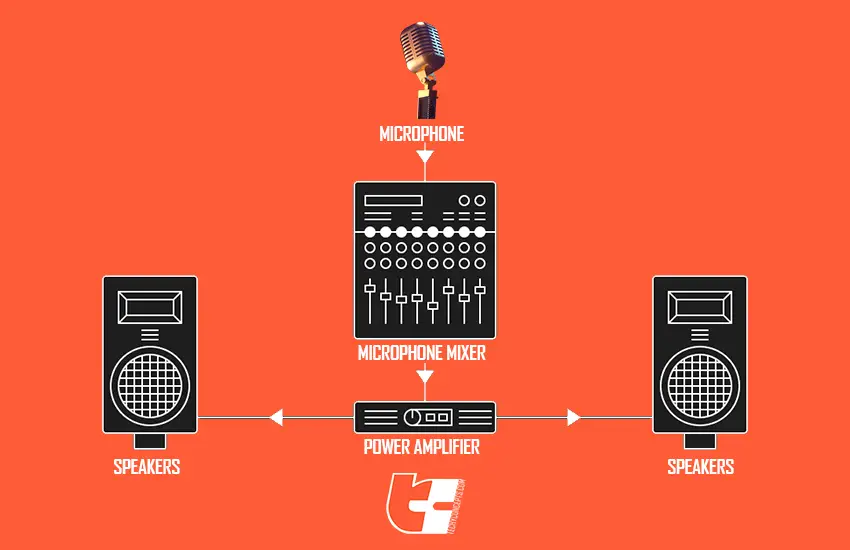If you’re a music lover who regularly hosts or goes to DJ parties and concerts, you must have come across the term “PA speakers” somewhere – perhaps on social media or from friends. Were you baffled, wondering to yourself, “What Does PA Stand For in Speakers?”
In a nutshell, PA is an abbreviated form of the phrase ‘Public Address’ which is used to label sound systems that are specifically designed to amplify weak or low sound signals to louder and stronger ones, for the entertainment of big crowds of people in large spaces. A PA sound system is generally used in a variety of settings – such as, live music venues, meeting/ conference rooms, reception hall rooms, academic programs etc.
Curious to learn more about PA systems? Well, your wish is our command! In this article, we are going to dive deeper into the world of PA speakers so stick around with us.

What Does a PA System Do?
Its main job is to amplify sounds. As a result, the audience will be able to hear speech and music more loudly and clearly.
For instance, imagine you’re the host of a live music concert, if you set up a PA system, all the audience in the back rows will be able to hear the performers on stage. Similarly, in a conference room, with the help of a PA system, you can ‘amplify’ or improve the presenter’s voice so that everyone in the room can hear clearly.
What Are the Main Components of a PA System?
Although the exact number of components in a PA system heavily depends on the size and type you own, we can still give you an overall idea. Most PA systems typically include microphones, mixers, amplifiers, speakers, and a wiring set. Each part plays an important role in determining the overall performance of your PA system.

1. Microphones
Microphones are needed to capture sound waves of different ranges and turn them into electrical signals.
2. Mixers
Mixers are another crucial component – they receive the electrical signals sent over by the microphones and combine them together. They also adjust the level of each signal so that they are all equalised and stable.
3. Amplifiers
Amplifiers, as you can guess, ‘amplify’ audio signals. They basically boost up the strength of a signal so that it can be sent over to the next station – the speakers. But, not all PA systems may require an additional amplifier, it depends on the type of speakers you have – powered or passive.
4. Speakers
The job of speakers in a PA system is like that of the UNO reverse card, they turn electrical signals back into sound waves so that people can hear them. Some PA systems use active speakers while some use passive instead.
Quick difference: In a PA speaker, the amplifier is pre-built inside the speaker itself. You don’t need to buy an extra one. Whereas, for passive speakers, you will require an external amplifier to make sure that audio signals are strong enough to be amplified.
5. Cabling/Wiring Set
The Cables (i.e – RCA, TOSLink, AUX etc.) connect all these different components of a PA system together so that they can function smoothly as one unit. If you are using PA for a live band in a large venue, you will also require some additional components, like:
6. DI Boxes
With all the long wirings needed on stage for a large band, you may also find a DI box useful particularly for guitar signals, as it can boost the signals without causing any external noise into your mixer.
7. Monitors
Well, monitors could be needed and placed at different parts of the big stage, so that all the band members can hear themselves clearly amidst the loud cheers of the audience.
Is a PA System Worth Investing? – Advantages of Owning a PA System
If you need to ensure the best sound quality possible in an important large event – such as for conference meetings, performances and presentations – PA speaker system will definitely be a good investment.
But remember, whether they are worthwhile to spend your hard-earned money on is dependent on your specific needs. If you routinely host events or need clear and powerful sound projection every now and then, investing in high-quality PA speakers can improve the overall audio experience for both artists and audiences.
Here is a brief overview of the benefits of using PA speakers:
1. Projection and Volume
PA speakers are designed to project sound over longer distances and cover larger areas, allowing the audience to hear well even in busy surroundings.
2. Convenience
Active PA speakers include built-in amplifiers, which simplifies setup by eliminating the need for separate amplification equipment.
3. Multi-purposes
They may be used for a variety of events, including concerts and festivals, as well as conferences and outdoor meetings.
4. Precision and Clarity
PA speakers are designed to provide clear and balanced sound even at high volumes, without any distortion or buzzing noises.
5. Customization Options:
You can choose different types and sizes of PA speakers to match the size and nature of the venue based on your preferences.
6. Easy Portability
Many modern PA speaker systems are not so heavy as expected and are portable, making them ideal for mobile DJs, bands, and entertainers.
7. Versatile Adjustability
To suit larger crowds or more sophisticated settings, PA systems may be expanded and altered by adding extra speakers, amplifiers, and mixers.
What is the Difference Between a PA System and an Amplifier?
Okay, so, you may have been wondering to yourself – a PA system amplifies sound signals, but at the same time isn’t that what amplifiers do? Well, don’t be puzzled. Let us tell you the key difference between an amplifier and a PA sound system.
In layman’s terms, a PA system refers to the “entire system” that works to amplify sound and provide an overall better sound quality, including the microphone, amplifier, mixer, speakers, etc.
On the other hand, an amplifier, just refers to the amplification unit. The part in the signal chain that amplifies sound.
Because a PA system can more or less amplify sound signals at different frequency levels, from bass to high-pitch voices and instruments, it’s safe to conclude that a PA system is the best option for amplifying than a single amplifier equipment.
Do I Need A PA System?
Good question! Here’s the thing – it depends on what you really want to use a PA sound system for. But in general, there are numerous reasons for why you might require a PA system:
- If you are having an event with numerous speakers, you are likely to need a PA system to ensure that everyone can be heard loud and clear.
- If you are a musician performing in a live concert on stage, a PA system may be required to boost your performance and confidence.
- A PA system is basically required in any event where it’s important that the performers are heard by a medium to large audience.
- Because PA systems may be rented, it is a good idea to do so before purchasing or investing to have a sense of how they perform and what you truly need for your sound needs.
Final Thoughts
Well, we hope we could clear the fog revolving PA speaker system. Remember, the technical specifications of a PA system will vary depending on its size, type and purpose.
Although there’s no doubt you’ve benefited from this article, still the best way to learn about a PA system is to get actual hands-on experience. You can speak to local venues to see how their systems work or even volunteer at live gigs or events to get some real-world hands-on experience with a PA system.
Frequently Asked Questions:
1. What is the difference between a PA speaker and a regular speaker?
Answer: Regular and PA speakers differ in purpose, design and performance characteristics.
A PA (Public Address) speaker is designed for amplifying sound over larger areas and generally used in big events and public spaces. It prioritises volume and projection. Regular speakers are intended for personal use and focus on delivering accurate and detailed sound reproduction.
2. Why is it called a PA speaker?
Answer: The term “PA” stands for “Public Address.” PA speakers are designed to amplify sound over wide areas, making them perfect for addressing or communicating with a larger audience. The term “PA speaker” emphasises their primary function of delivering clear and audible announcements or messages in public settings, such as concerts, rallies, and events.
3. Is a PA an amplifier?
Answer: No, a PA (Public Address) is not an amplifier but a whole stereo system that includes amplifiers and some other crucial components, such as mixers, microphones, and speakers. The amplifier is just one part of the PA system and is responsible for boosting the audio signal to a level suitable for driving the PA speakers. The PA speakers, on the other hand, are the equipment that actually produce the sound and distribute it over a larger area.
4. Are PA speakers active or passive?
Answer: It could be either of them. Active PA speakers will already have built-in amplifiers. This means they can receive a line-level audio signal directly from a mixer or other sources and amplify it to produce sound.
Passive PA speakers, however, do not have built-in amplifiers. You’ll need to get an external amplifier in your PA system.
